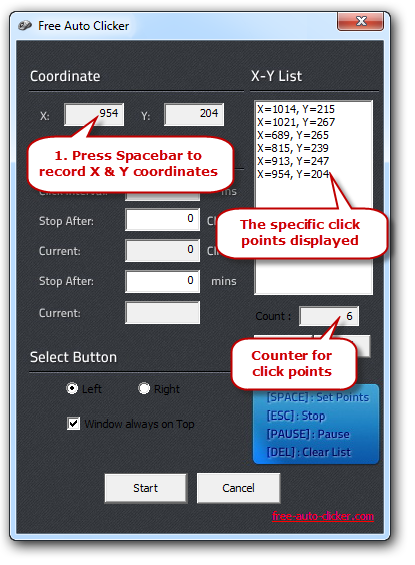
- WINDOWS GET MOUSE COORDINATES .EXE
- WINDOWS GET MOUSE COORDINATES UPDATE
- WINDOWS GET MOUSE COORDINATES CODE
WINDOWS GET MOUSE COORDINATES CODE
Then run the C# code and ensure the counter indeed increments in the VB6 window.
WINDOWS GET MOUSE COORDINATES .EXE
exe "Properties") and minimize it's window.

PostMessage(hWnd, WM_LBUTTONUP, 0, lParam) PostMessage(hWnd, WM_LBUTTONDOWN, MK_LBUTTON, lParam) In the search box on your task bar, search for Mouse, and select it from the list. Retrieves the X and Y screen coordinates of the mouse cursor. Int lParam = MAKELPARAM(62, 68) // Button coordinates relative to window "client area" All the best, NwN at 2:55pm FatalSleep (35) Meant for C++, same deal though at 2:56pm closed account ( o3hC5Di1) Yes, same deal. You probably need to be looking into the API of the specific platform you are targeting. PostMessage(hWnd, WM_ACTIVATE, WA_ACTIVE, 0) Mouse pointers are part of the window manager system, therefore they are highly platform dependent. IntPtr hWnd = FindWindowB圜aption(IntPtr.Zero, "Form1") Static extern int PostMessage(IntPtr hWnd, uint Msg, int wParam, int lParam) Static extern IntPtr FindWindowB圜aption(IntPtr ZeroOnly, string lpWindowName) The Get Mouse Position command locates the current position of the mouse cursor on the screen or window and saves the X and Y coordinates to Integer variables. The trick is to first send WM_ACTIVATE message, then the WM_LBUTTONDOWN/UP pair: using For me it simulates the click even for minimized window.

I tested the following code on VB6 app with windowless button. You just have to ensure that you are sending the messages to the container window (the one that has its hWnd handle). 8086 Assemblyedit This returns the mouses horizontal position in CX and its vertical position in DX, assuming the mouse has been enabled first. Please specify if the window may be externally created. In my experience, though, as long as you're using this hook on smaller components that don't have a big DOM impact, you should be just fine.The fact that your controls are windowless, doesn't prevent you from doing that. Get the current location of the mouse cursor relative to the active window. Eliminates the frustrating search of your screen.
WINDOWS GET MOUSE COORDINATES UPDATE
Use this hook in the small “leaf node” components near the bottom of the tree.įor maximum performance, you can use a library like React Spring or Framer Motion, which will allow you to update values without triggering React renders. Ctrl+Shift+W - brings settings window Ctrl+Shift+X - Toggle Static Circle visibility Ctrl+Shift+C - Toggle Aim lines visibilty Highly visible locator instantly reveals your mouse position. Save the file as 'mouse.js' on your desktop. How Do I Create Desktop Shortcuts for Google Maps This will display the mouse coordinates for the next 100. It shouldn't be used in a top-level component like App or Homepage, since that will cause a huge chunk of your React tree to re-render very often. Click 'Notepad' to open Notepad on your computer.

That said, you do still need to be a bit careful where you use this hook. No matter how hard I tried, I couldn't come up with a contrived scenario where the throttle actually improved performance (while still updating often enough for smooth animations). In testing, though, it seemed to make performance worse. Originally, this hook included “throttle” functionality, which would limit the updates to a user-specified interval. The JavaScript script presented in this page can be used to Get Mouse coordinates inside a HTML element, usually a Div or an Image. With this function you can get the x position of the mouse cursor (in pixels) within the browser if it is an HTML5 game or within the display if it is a Windows. This can be dozens and dozens of times a second. This component will re-render whenever the user moves the mouse.


 0 kommentar(er)
0 kommentar(er)
